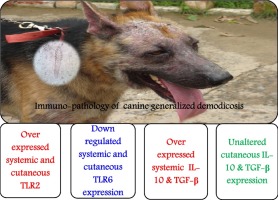当前位置:
X-MOL 学术
›
Vet. Parasitol.
›
论文详情
Our official English website, www.x-mol.net, welcomes your
feedback! (Note: you will need to create a separate account there.)
Quantification of immuno-regulatory cytokine and toll-like receptors gene expression in dogs with generalized demodicosis.
Veterinary Parasitology ( IF 2.0 ) Pub Date : 2020-02-25 , DOI: 10.1016/j.vetpar.2020.109063 Sandeep P Soman 1 , Shanker K Singh 1 , Priyambada Kumari 2 , Soumen Choudhury 3 , Alok Singh 1 , Sarita Kanwal 1 , Richa Khushboo 1 , Satish K Garg 3
Veterinary Parasitology ( IF 2.0 ) Pub Date : 2020-02-25 , DOI: 10.1016/j.vetpar.2020.109063 Sandeep P Soman 1 , Shanker K Singh 1 , Priyambada Kumari 2 , Soumen Choudhury 3 , Alok Singh 1 , Sarita Kanwal 1 , Richa Khushboo 1 , Satish K Garg 3
Affiliation

|
The proliferation of Demodex mites is mainly controlled by host immunity; however, the precised mechanism of host-mite interplay and host immune response in the cutaneous microenvironment of dogs with generalized demodicosis (GD) are not yet established. In the present study, we envisaged the alterations in the expression of toll-like receptors (TLRs) and immuno-regulatory cytokine gene in the skin lesions and peripheral blood mononuclear cells (PBMCs) of dogs with GD. The expression of TLR2, TLR6, IFN-γ, TGF-β and IL-10 genes in the skin lesions and PBMCs of 15 dogs with GD was quantified by qRT-PCR. Compared to healthy dogs, significantly elevated expression of TLR2 (P = 0.048), TGF-β (P = 0.04) and IL-10 (P = 0.012) were found in the PBMCs of dogs with GD. Conversely, there was significantly reduced expression of TLR6 gene (P = 0.021) in the PBMCs of these dogs. The infested dogs also revealed significantly elevated expression of TLR2 gene (P = 0.034) in the skin lesions, while, the expression of the TLR6 gene was found to be significantly (P = 0.004) reduced. Interestingly, significant alterations in TGF-β (P = 0.105) and IL-10 (P = 0.162) genes expression were not observed in the skin lesions of diseased dogs. Our findings suggest that Demodex mites contribute to a different systemic and cutaneous immune response in dogs for their proliferation, and consequently the development of GD. Therefore, Demodex mites might be inducing the immunosuppression through activating the systemic over-expression of immunosuppressive cytokines; however, in the cutaneous lesions, the expression of immunosuppressive cytokines remained unaltered. Both systemic and local over-expression of TLR2 and reduced expression of TLR6 genes might be responsible for the inflammatory signs of canine demodicosis and helping to the mite to escape the host immunity.
中文翻译:

定量检测患有全身蠕虫病的狗中免疫调节细胞因子和toll样受体的基因表达。
蠕形螨的繁殖主要受宿主免疫力的控制。然而,尚未建立精确的机制,在患有全身蠕虫病(GD)的犬的皮肤微环境中,宿主与螨之间的相互作用和宿主免疫反应的机制尚未建立。在本研究中,我们设想了GD犬皮肤损伤和外周血单个核细胞(PBMC)中toll样受体(TLR)和免疫调节细胞因子基因表达的变化。通过qRT-PCR定量检测15只GD狗的皮肤损伤和PBMCs中TLR2,TLR6,IFN-γ,TGF-β和IL-10基因的表达。与健康犬相比,GD犬的PBMC中TLR2(P = 0.048),TGF-β(P = 0.04)和IL-10(P = 0.012)的表达明显升高。相反,TLR6基因的表达显着降低(P = 0。021)在这些狗的PBMC中。受感染的狗还显示出皮肤损伤中TLR2基因的表达显着升高(P = 0.034),而发现TLR6基因的表达显着降低(P = 0.004)。有趣的是,在患病犬的皮肤损伤中未观察到TGF-β(P = 0.105)和IL-10(P = 0.162)基因表达的显着改变。我们的发现表明,蠕形螨对狗的增殖和因此导致的GD产生不同的全身和皮肤免疫应答。因此,蠕形螨可能是通过激活免疫抑制细胞因子的系统性过度表达来诱导免疫抑制的。然而,在皮肤病变中,免疫抑制细胞因子的表达保持不变。
更新日期:2020-03-20
中文翻译:

定量检测患有全身蠕虫病的狗中免疫调节细胞因子和toll样受体的基因表达。
蠕形螨的繁殖主要受宿主免疫力的控制。然而,尚未建立精确的机制,在患有全身蠕虫病(GD)的犬的皮肤微环境中,宿主与螨之间的相互作用和宿主免疫反应的机制尚未建立。在本研究中,我们设想了GD犬皮肤损伤和外周血单个核细胞(PBMC)中toll样受体(TLR)和免疫调节细胞因子基因表达的变化。通过qRT-PCR定量检测15只GD狗的皮肤损伤和PBMCs中TLR2,TLR6,IFN-γ,TGF-β和IL-10基因的表达。与健康犬相比,GD犬的PBMC中TLR2(P = 0.048),TGF-β(P = 0.04)和IL-10(P = 0.012)的表达明显升高。相反,TLR6基因的表达显着降低(P = 0。021)在这些狗的PBMC中。受感染的狗还显示出皮肤损伤中TLR2基因的表达显着升高(P = 0.034),而发现TLR6基因的表达显着降低(P = 0.004)。有趣的是,在患病犬的皮肤损伤中未观察到TGF-β(P = 0.105)和IL-10(P = 0.162)基因表达的显着改变。我们的发现表明,蠕形螨对狗的增殖和因此导致的GD产生不同的全身和皮肤免疫应答。因此,蠕形螨可能是通过激活免疫抑制细胞因子的系统性过度表达来诱导免疫抑制的。然而,在皮肤病变中,免疫抑制细胞因子的表达保持不变。










































 京公网安备 11010802027423号
京公网安备 11010802027423号